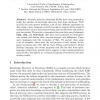Free Online Productivity Tools
i2Speak
i2Symbol
i2OCR
iTex2Img
iWeb2Print
iWeb2Shot
i2Type
iPdf2Split
iPdf2Merge
i2Bopomofo
i2Arabic
i2Style
i2Image
i2PDF
iLatex2Rtf
Sci2ools
CINQ
2004
Springer
2004
Springer
Query Languages Supporting Descriptive Rule Mining: A Comparative Study
Recently, inductive databases (IDBs) have been proposed to tackle the problem of knowledge discovery from huge databases. With an IDB, the user/analyst performs a set of very different operations on data using a query language, powerful enough to support all the required manipulations, such as data preprocessing, pattern discovery and pattern post-processing. We provide a comparison between three query languages (MSQL, DMQL and MINE RULE) that have been proposed for descriptive rule mining and discuss their common features and differences. These query languages look like extensions of SQL. We present them using a set of examples, taken from the real practice of rule mining. In the paper we discuss also OLE DB for Data Mining and Predictive Model Markup Language, two recent proposals that like the first three query languages respectively provide native support to data mining primitives and provide a description in a standard language of statistical and data mining models.
CINQ 2004 | Data Mining | Database | Query Languages | Rule Mining |
| Added | 20 Aug 2010 |
| Updated | 20 Aug 2010 |
| Type | Conference |
| Year | 2004 |
| Where | CINQ |
| Authors | Marco Botta, Jean-François Boulicaut, Cyrille Masson, Rosa Meo |
Comments (0)

